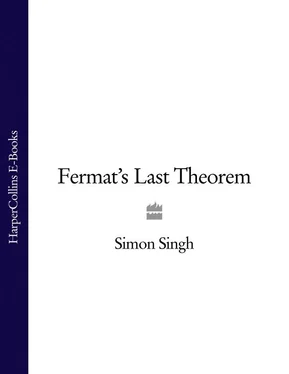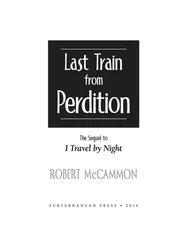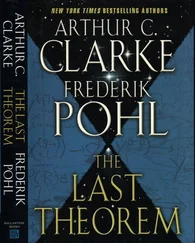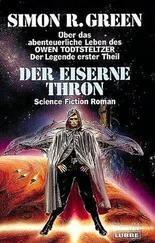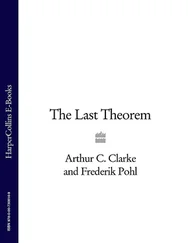You can now measure the longest side z , the so-called hypotenuse, and square this length. The remarkable result is that this number z 2is identical to the one you just calculated, i.e. 5 2= 25. That is to say,
In a right-angled triangle the square on the hypotenuse is equal to the sum of the squares on the other two sides.
Or in other words (or rather symbols):
This is clearly true for the triangle in Figure 1, but what is remarkable is that Pythagoras’ theorem is true for every right-angled triangle you can possibly imagine. It is a universal law of mathematics, and you can rely on it whenever you come across any triangle with a right angle. Conversely if you have a triangle which obeys Pythagoras’ theorem, then you can be absolutely confident that it is a right-angled triangle.
At this point it is important to note that, although this theorem will forever be associated with Pythagoras, it was actually used by the Chinese and the Babylonians one thousand years before. However, these cultures did not know that the theorem was true for every right-angled triangle. It was certainly true for the triangles they tested, but they had no way of showing that it was true for all the right-angled triangles which they had not tested. The reason for Pythagoras’ claim to the theorem is that it was he who first demonstrated its universal truth.
But how did Pythagoras know that his theorem is true for every right-angled triangle? He could not hope to test the infinite variety of right-angled triangles, and yet he could still be one hundred per cent sure of the theorem’s absolute truth. The reason for his confidence lies in the concept of mathematical proof. The search for a mathematical proof is the search for a knowledge which is more absolute than the knowledge accumulated by any other discipline. The desire for ultimate truth via the method of proof is what has driven mathematicians for the last two and a half thousand years.
The story of Fermat’s Last Theorem revolves around the search for a missing proof. Mathematical proof is far more powerful and rigorous than the concept of proof we casually use in our everyday language, or even the concept of proof as understood by physicists or chemists. The difference between scientific and mathematical proof is both subtle and profound, and is crucial to understanding the work of every mathematician since Pythagoras.
The idea of a classic mathematical proof is to begin with a series of axioms, statements which can be assumed to be true or which are self-evidently true. Then by arguing logically, step by step, it is possible to arrive at a conclusion. If the axioms are correct and the logic is flawless, then the conclusion will be undeniable. This conclusion is the theorem.
Mathematical theorems rely on this logical process and once proven are true until the end of time. Mathematical proofs are absolute. To appreciate the value of such proofs they should be compared with their poor relation, the scientific proof. In science a hypothesis is put forward to explain a physical phenomenon. If observations of the phenomenon compare well with the hypothesis, this becomes evidence in favour of it. Furthermore, the hypothesis should not merely describe a known phenomenon, but predict the results of other phenomena. Experiments may be performed to test the predictive power of the hypothesis, and if it continues to be successful then this is even more evidence to back the hypothesis. Eventually the amount of evidence may be overwhelming and the hypothesis becomes accepted as a scientific theory.
However, the scientific theory can never be proved to the same absolute level of a mathematical theorem: it is merely considered highly likely based on the evidence available. So-called scientific proof relies on observation and perception, both of which are fallible and provide only approximations to the truth. As Bertrand Russell pointed out: ‘Although this may seem a paradox, all exact science is dominated by the idea of approximation.’ Even the most widely accepted scientific ‘proofs’ always have a small element of doubt in them. Sometimes this doubt diminishes, although it never disappears completely, while on other occasions the proof is ultimately shown to be wrong. This weakness in scientific proof leads to scientific revolutions in which one theory which was assumed to be correct is replaced with another theory, which may be merely a refinement of the original theory, or which may be a complete contradiction.
For example, the search for the fundamental particles of matter involved each generation of physicists overturning or, at the very least, refining the theory of their predecessors. The modern quest for the building blocks of the universe started at the beginning of the nineteenth century when a series of experiments led John Dalton to suggest that everything was composed of discrete atoms, and that atoms were fundamental. At the end of the century J. J. Thomson discovered the electron, the first known subatomic particle, and therefore the atom was no longer fundamental.
During the early years of the twentieth century, physicists developed a ‘complete’ picture of the atom – a nucleus consisting of protons and neutrons, orbited by electrons. Protons, neutrons and electrons were proudly held up as the complete ingredients for the universe. Then cosmic ray experiments revealed the existence of other fundamental particles – pions and muons. An even greater revolution came with the discovery in 1932 of antimatter – the existence of antiprotons, antineutrons, antielectrons, etc. By this time particle physicists could not be sure how many different particles existed, but at least they could be confident that these entities were indeed fundamental. That was until the 1960s when the concept of the quark was born. The proton itself is apparently built from fractionally charged quarks, as is the neutron and the pion. The moral of the story is that physicists are continually altering their picture of the universe, if not rubbing it out and starting all over again. In the next decade the very concept of a particle as a point-like object may even be replaced by the idea of particles as strings – the same strings which might best explain gravity. The theory is that strings a billionth of a billionth of a billionth of a billionth of a metre in length (so small that they appear point-like) can vibrate in different ways, and each vibration gives rise to a different particle. This is analogous to Pythagoras’ discovery that one string on a lyre can give rise to different notes depending on how it vibrates.
The science fiction writer and futurologist Arthur C. Clarke wrote that if an eminent professor states that something is undoubtedly true, then it is likely to be proved false the next day. Scientific proof is inevitably fickle and shoddy. On the other hand mathematical proof is absolute and devoid of doubt. Pythagoras died confident in the knowledge that his theorem, which was true in 500 BC, would remain true for eternity.
Science is operated according to the judicial system. A theory is assumed to be true if there is enough evidence to prove it ‘beyond all reasonable doubt’. On the other hand mathematics does not rely on evidence from fallible experimentation, but it is built on infallible logic. This is demonstrated by the problem of the ‘mutilated chessboard’, illustrated in Figure 2.
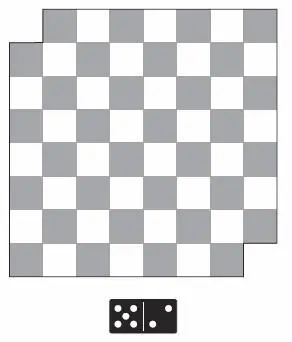
Figure 2. The problem of the mutilated chessboard.
We have a chessboard with the two opposing corners removed, so that there are only 62 squares remaining. Now we take 31 dominoes shaped such that each domino covers exactly two squares. The question is: is it possible to arrange the 31 dominoes so that they cover all the 62 squares on the chessboard?
Читать дальше
